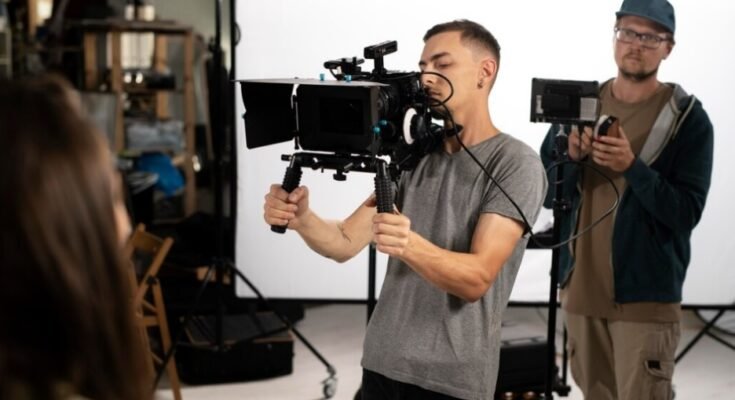In a world increasingly dominated by visual storytelling, digital filmmaking and video production have emerged as powerful tools for creators and businesses alike. But what exactly lies behind these terms? This comprehensive guide delves into the exciting realm of digital filmmaking and video production, exploring its core principles, the equipment involved, and the captivating possibilities it unlocks.
From Celluloid to Pixels: A Digital Revolution
Traditionally, filmmaking involved capturing images on light-sensitive film. This process, while still revered for its unique aesthetic, was labor-intensive and expensive. Digital filmmaking, on the other hand, utilizes electronic sensors to capture images and sound. This digital revolution has transformed the filmmaking landscape, offering several key advantages:
- Accessibility: Digital cameras are vastly more affordable than traditional film cameras, making filmmaking accessible to a wider range of creators.
- Versatility: Digital cameras allow for immediate review of footage, enabling real-time adjustments and a more efficient workflow.
- Cost-Effectiveness: Digital filmmaking eliminates the cost of film stock and processing, allowing for greater experimentation and cost-effective production.
- Special Effects: Digital technology allows for the creation of breathtaking special effects, opening doors to limitless creative possibilities.
The Digital Filmmaking Toolbox: Essential Equipment
While the specific equipment used can vary depending on the project’s scale and budget, some core elements form the foundation of a digital filmmaking setup:
- Digital Camera: This is the heart of your digital filmmaking setup. Cameras come in a variety of sizes and capabilities, with options ranging from compact mirrorless cameras to high-end cinema cameras.
- Lenses: Lenses play a crucial role in determining the visual style of your film. Understanding different focal lengths and aperture settings is essential for capturing stunning visuals.
- Audio Equipment: Crisp, clear audio is equally important as visuals. Consider microphones, recorders, and other audio equipment to ensure high-quality sound capture.
- Lighting: Lighting sets the mood and atmosphere of your film. Understanding lighting techniques and utilizing appropriate lighting equipment can significantly elevate the production value of your project.
- Tripods & Stabilizers: Shaky camera work can be distracting. Utilizing tripods, gimbals, or other stabilization tools ensures smooth, professional-looking footage.
- Editing Software: Once you’ve captured your footage, it’s time to bring your vision to life. Video editing software allows you to weave together clips, add effects, and create a cohesive narrative.
The Art of Storytelling: The Core of Digital Filmmaking
Digital filmmaking is not just about fancy equipment. It’s about harnessing the power of visual storytelling to connect with audiences. Here are some fundamental aspects to consider:
- Pre-Production: This stage involves developing your story concept, writing a script, storyboarding shots, and planning your production schedule.
- Production: This is where you bring your script to life, capturing footage and audio according to your plan.
- Post-Production: The editing magic happens here! You edit your footage, add transitions, sound effects, and music to create the final film.
Beyond Hollywood: A World of Video Production Applications
While filmmaking traditionally focuses on creating narrative stories, digital video production encompasses a broader range of applications. Here are some prominent examples:
- Corporate Video Production: Businesses of all sizes utilize video production to create promotional videos, explain product features, showcase company culture, and connect with customers.
- Event Videography: Capture weddings, conferences, concerts, or other live events in a captivating way through video production.
- Educational Videos: Create engaging and informative educational content through video tutorials, online courses, or explainer videos.
- Social Media Content: Video content reigns supreme on social media platforms. Short, eye-catching videos can grab attention, promote brands, and connect with social media audiences.
- Webinars & Video Marketing: Video plays a crucial role in online marketing strategies. Create engaging webinars, product demo videos, or customer testimonials to drive engagement and sales.
The Digital Frontier: Embracing New Technologies
The landscape of digital filmmaking and video production is constantly evolving. Here are some exciting new technologies transforming the field:
- Drone Footage: Drones offer breathtaking aerial perspectives, adding a new dimension to video productions.
- Virtual Reality (VR) & Augmented Reality (AR): These emerging technologies create immersive video experiences, offering viewers a deeper connection to the content.
- 360-Degree Video: Capture footage from every direction, allowing viewers to explore the scene virtually.
- Livestreaming: Livestreaming platforms like YouTube Live or Twitch enable real-time video broadcasting to a global audience.
In Conclusion: A World of Creative Possibilities
In Conclusion: A World of Creative Possibilities Awaits
Digital filmmaking and video production have democratized storytelling, empowering creators and businesses alike to share their visions with the world. From crafting captivating narratives to creating engaging marketing content, the possibilities are boundless.
So, how do you embark on your own digital filmmaking journey? Here are some key takeaways:
- Start Small & Experiment: Don’t be intimidated by professional equipment. Even a smartphone can be a powerful filmmaking tool. Begin with small projects, experiment, and hone your skills.
- Learn the Fundamentals: Master the basics of storytelling, camera operation, lighting, and sound design. Online tutorials, workshops, and film schools offer valuable resources.
- Find Your Community: Connect with other filmmakers and video editors. Share ideas, collaborate on projects, and learn from each other’s experiences.
- Practice Makes Perfect: The more you create, the better you’ll become. Embrace the learning process and continuously refine your craft.
- Embrace New Technologies: Stay informed about emerging technologies and explore how they can elevate your productions.
The world of digital filmmaking and video production is a realm brimming with creative possibilities. With dedication, passion, and a willingness to learn, you can transform your vision into captivating videos that resonate with audiences and leave a lasting impact. Remember, the most powerful tool you possess is your imagination. So, grab your camera, unleash your creativity, and get ready to share your story with the world, one frame at a time.
This post was written by a professional at https://cineview.us/. CineView Studios is a full-service video production and photography company based in the Tampa Bay Area on Florida’s Gulf Coast. With a steadfast commitment to excellence and creativity, we take pride in providing the best services to clients throughout the entire Southeast region. Whether you need corporate video production near you, production trailer rentals, lighting packages, camera crew for hire, or mobile DIT kits near you, CineView Studios has you covered. Whether you’re based in Florida’s Gulf Coast or anywhere in the Southeast, we’re here to serve you. Contact us today to discuss your video production and photography needs, and let us take your vision to the next level.




